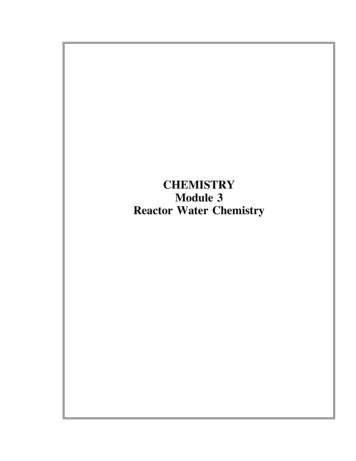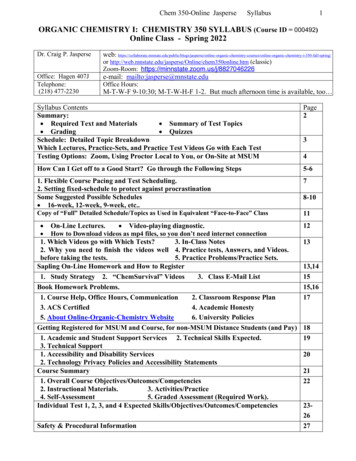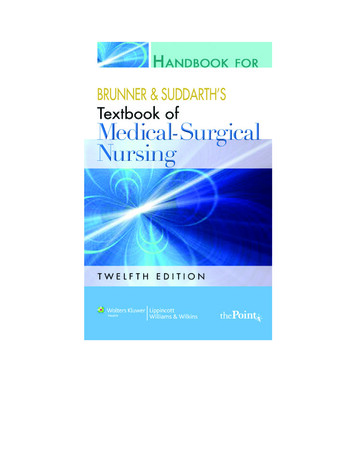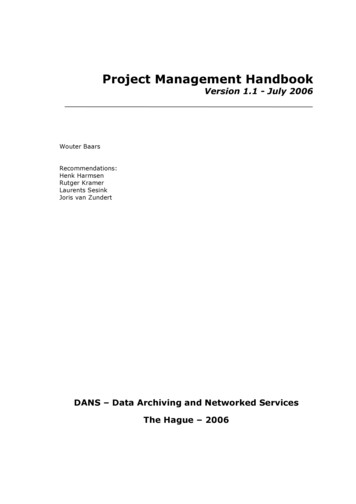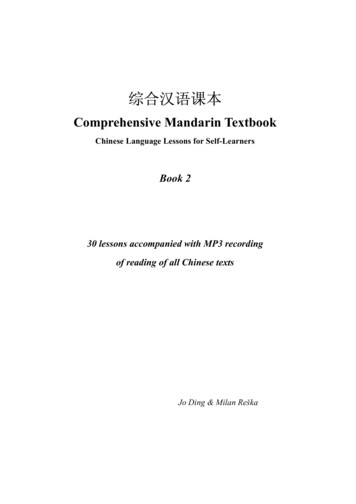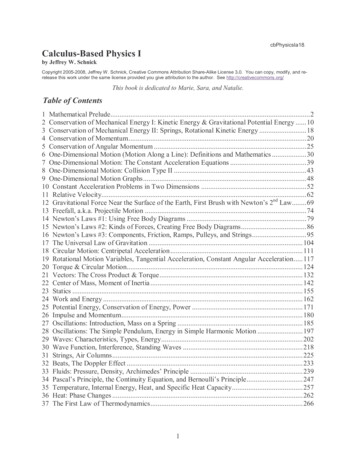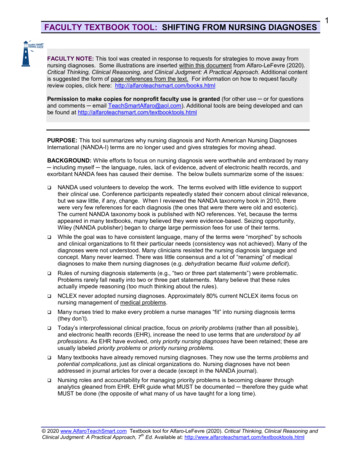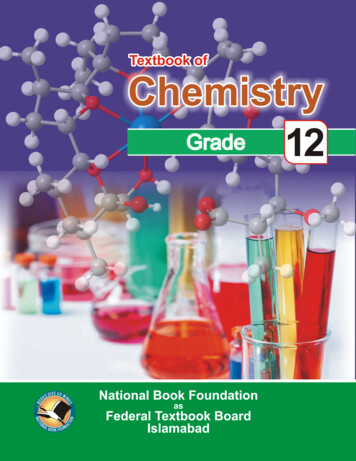
Transcription
Textbook ofChemistryGrade12
Textbook ofChemistryGrade12National Book FoundationasFederal Textbook BoardIslamabad
OUR MOTTOStandardsOutcomesAccessStyle 2015 National Book Foundation as Federal Textbook Board, Islamabad.All rights reserved. This volume may not be reproduced in whole or in part in anyform (abridged, photo copy, electronic etc.) without prior written permission fromthe publisher.Textbook ofChemistry Grade - 12Content AuthorElaborator / DesignerComposerEditorDesk OfficerDirector Textbook Dev.Management ofSupervision of::::::::Prof. Mian Muhammad Usman, Prof. Mian Abdul HamidHafiz Rafiuddin, Mr. Shahzad AhmadMr. Amir JaveedMr. Majeed-ur-Rehman MalikDr. Shafqat Ali Janjua (AEA)Mr. Jahan Khan JamroMr. Aftab SoomroProf. Dr. Attash Durrani, (T.I)First Edition:2015 Qty:PriceCodeISBNPrinter::::for Information about other National Book Foundation Publications, visit our Web sitehttp://www.nbf.org.pk or call 92-51-9261125or Email us at: books@books@nbf.org.pk
PREFACECHEMISTRY for GRADE - 12 is developed according to the National Curriculum 2006and National Style Guide. It is presented under the management and supervision of textbookdevelopment principles and guidelines, design and layout.This textbook provides several ways to develop this approach. Wherever an importantnew skill or concept is introduced, you will find a worked-out example. A special feature of thebook is that the text has been illustrated with a large number of diagrams and the data presentedin the form of numberous tables and comparison.There has accordingly been a distinct change in approach and content with the result thata shortage of suitable text written on these lines was being keenly felt. The authors seekjustification in presenting the present volume in the sincere attempts that they have made to fillup the requisition.Considerable thought has been given to the topics for discussion. The great care hasbeen taken to elucidate the fundamentals and the approach to discussion in modern throughout.Particular mention may be made in this connection of the chapter on Transition Elements,Analytical Chemistry, Biochemistry, Environmental Chemistry and the most important inOrganic portion.There is a possibility of finding the errors, mistakes, omissions and lack of continuity ofideas somewhere in the book. So any suggestion to make the book better will be appreciated. Itwill make you to hep us and will cause the uplifting of the standard of the book and ultimatelynation. Actually we need cooperation in the form of liberal criticism and valuable suggestionsfrom the fellow teachers and students. It will be gratefully received and acknowledged.Our efforts are to make textbooks teachable with quality, i.e. maintaining of standards. Itis a continuous effort and we will get feedback of the yearly feasibility reports and redesign thetextbook every year.Quality of Standards, Pedagogical Outcomes, Taxonomy Access and Actualization ofStyle is our motto.With these elaborations, this series of new development is presented for use.Prof. Dr. Inam ul Haq Javeid(Pride of Performance)Managing DirectorNational Book Foundation
CONTENTSNo.Chapter Name13s AND p - BLOCK ELEMENTS614d AND f BLOCK ELEMENTS6415ORGANIC COMPOUNDS10416HYDROCARBONS11817ALKYL HALIDE AND AMINE17618ALCOHOL, PHENOLS AND ETHRS20419ALDEHYDES AND KETONES22420CARBONYL COMPOUNDS25021BIOCHEMISTRY27422INDUSTRIAL CHEMISTRY31023ENVIRONMENTAL CHEMISTRY34024ANALYTICAL CHEMISTRY368Reference BooksPeriodic TableTable of Atomic MassesTable of Electronic ConfiguratoinP. No.
613 s and p – Block Elements13s AND p - BLOCKELEMENTSAfter completing this lesson, youwill be able to: This is 28 days lesson(period including homework)Recognize the demarcation of Periodic Table into s block, p block d block, and f block.Describe how physical properties like atomic radius, ionization energy, electro negativity, electrical conductivityand melting and boiling points of element change within a group and within a period and the Periodic Table.Describe reactions of period 3 elements with water, oxygen and chlorine.Describe reaction of oxides and chlorides of period 3 elements with water.Describe reaction of group I elements with water, oxygen and chlorine.Describe reaction of group I elements with water, oxygen and chlorine.Discuss the trend in solubility f the hydroxides, sulphates and carbonates of group II elements. Discuss the trends in thermal stability of the nitrates and carbonates of group II elements.Explain the trends in physical properties and oxidation states in group I, II IV and VII of the periodic table.Explain effects of heat on nitrates, carbonates and hydrogen carbonated of Group I elements. Differentiate beryllium from other members of its group.Reading13.1 PERIOD 3 (Na TO Ar)13.1.1Atomic and Physical Properties of the Period 3 Elements(This period contains Na, Mg, Al, Si, P, S, Cl and Ar)This topic describes and explains the trends in atomic and physical properties of the Period3 elements from sodium to argon. It covers ionization energy, atomic radius, electronegativity,electrical conductivity, melting point and boiling point.(a) Atomic PropertiesElectronic StructuresIn Period 3 of the Periodic Table, the 3s and 3p orbitals are filling with electrons. Just as areminder, the shortened versions of the electronic structures for the eight elements are:Na[Ne] 3s1Mg[Ne] 3s2Al[Ne] 3s2 3px1Si[Ne] 3s2 3px1 3py1
713 s and p – Block ElementsP[Ne] 3s2 3px1 3py1 3pz1S[Ne] 3s2 3px2 3py1 3pz1Cl[Ne] 3s2 3px2 3py2 3pz1Ar[Ne] 3s2 3px2 3py2 3pz2In each case, [Ne] represents the complete electronic structure of a neon atom.Quick Quiz1. The electron structure of Mg is 1s2, 2s2, 2p6, 3s2. Write down electron structure of Al inthe same notation.2. Which of the two elements Mg or Al has the more stable structure?Trends in Atomic RadiusWe know that the number of shells in all the elements of a given periods remains thesame but the value of effective nuclear charge, increases from left to right. The increasedeffective nuclear charge pulls the electron cloud of the atom nearer to the nucleus and thus thesize of the atoms and ions goes on decreasing from left to right. Thus in going from left to rightin a period of s-and p-block elements atomic and ionic radi decrease with the increase of atomicnumber. This fact can be illustrated by considering the atomic (covalent) and ionic radii of theelements as shown below.Table 13.1: Ionic radii (inA 0 ) of representative elements (s-and p- block elements). In parentheses aregiven the oxidation states of the elements.Groups-block elementsPeriod12IAH2.08 (-1)2.09 ( 1)p-block elementsIIAIIIAIVAVAVIAVIIA2Li0.60 ( 1)Be0.31 ( 2)B0.20 ( 3)C2.60 (-4)0.15 ( 4)N1.71 (-3)0.11 ( 5)O1.40 (-2)0.09 ( 6)F1.36 (-1)0.07 ( 7)3Na0.95 ( 1)Mg0.65 ( 2)Al0.50 ( 3)Si2.71 (-1)0.41 ( 4)P2.12 (-3)0.34 ( 5)S1.84 (-2)0.29 ( 6)Cl1.81 (-1)0.26 ( 7)4K1.33 ( 1)Ca0.99 ( 2)Ga1.13 ( 1)0.62 ( 3)Ge0.93 ( 2)0.53 ( 4)As2.22 (-3)0.47 ( 5)Se1.98 (-2)0.42 ( 6)Br1.95 (-1)0.39 ( 7)5Rb1.48 ( 1)Sr1.13 ( 2)In1.32 ( 1)0.81 ( 3)Sn1.12 ( 2)0.71 ( 4)Sb0.45 (-3)0.62 ( 5)Te2.21 (-2)0.56 ( 6)I2.16 (-1)0.50 ( 7)6Cs1.69 ( 1)Ba1.35 ( 2)Ti1.40 ( 1)0.95 ( 3)Pb1.20 ( 2)0.84 ( 4)Bi1.20 ( 3)0.74 ( 5)Po-At-7Fr1.76 ( 1)Rs1.40 ( 2)
813 s and p – Block ElementsTrends in ElectronegativityElectro negativity is a measure of thetendency of an atom to attract a bonding pair ofelectrons.Fig. 13.1 ElectronegativitiesThe Pauling scale is the most commonlyused. Fluorine (the most electronegative element)is assigned a value of 4.0, and values range downto caesium and francium which are the leastelectronegative at 0.7.The TrendThe trend across Period 3 looks likethis:In going from left to right in a periodof s- and p-block elements, theelectronegativity values increase. Thisincrease can be explained on the basis ofany of the following facts.Fig 13.2 Periodic variations of electro negativity in sand p block elements are mentioned.(i)On moving from left to right in aperiod, there is a decrease in the size ofthe atoms. Smaller atoms have greatertendency to attract the electrons towardsthemselves i.e. smaller atoms havehigher electronegativity values.(ii)On moving from left to right in aperiod there is an increase of ionization energy and electron affinity of the elements. Theatoms of the elements, which have higher value of ionization energies and electronaffinities also have higher electro negativities.The variation of electro negativity in a period and a group of representative elements (sand p-block elements) is show in Fig. 13.2Notice that argon is not included. Electronegativity is about the tendency of an atom toattract a bonding pair of electrons. Since argon does not form covalent bonds, you obviouslycan't assign it electronegativity.Explaining the TrendThe trend is explained in exactly the same way as the trend in atomic radii.As you go across the period, the bonding electrons are always in the same level - the 3-level.They are always being screened by the same inner electrons.All that differs is the number of protons in the nucleus. As you go from sodium to chlorine,the number of protons steadily increases and so attracts the bonding pair more closely.
913 s and p – Block Elements(b) Physical PropertiesThis section is going to look at the electrical conductivity and the melting and boiling pointsof the elements. To understand these, you first have to understand the structure of each of theelements.Structures of the ElementsThe structures of the elements change as you go across the period. The first three (i.e. Na,Mg, Al) are metallic, silicon is giant covalent, and the rest (i.e. P, S, Cl, Ar) are simple molecules.Three Metallic StructuresSodium, magnesium and aluminium all have metallic structures.In sodium, only one electron per atom is involved in the metallic bond - the single 3s electron. Inmagnesium, both of its outer electrons are involved, and in aluminium all three.The coordination number of atoms in the metal crystal is also different in thesemetals.Sodium is 8-co-ordinated - each sodium atom is touched by only 8 otheratoms.Both magnesium and aluminium are 12-co-ordinated (although inslightly different ways). This is a more efficient way to pack atoms, leading toless wasted space in the metal structures and to stronger bonding in themetal.Fig 13.3A Giant Covalent StructureSilicon has a giant covalent structure just like diamond. A tiny part of the structure lookslike this: The structure is shown in figure 13.3.Four Simple Molecular StructuresThe structures of phosphorus (i.e. white etc) and sulphur (i.e. rhombic or monoclinic etc)vary depending on the type of phosphorus or sulphur you are talking about.The atoms in each of these molecules are held together by covalent bonds and argan is amonoatomic molecule.In the liquid or solid state, the molecules are held close to each other by Van der Waalsdispersion forces.Electrical Conductivity Sodium, magnesium and aluminium are all good conductors of electricity. Conductivityincreases as you go from sodium to magnesium to aluminium as they have free electrons Silicon is a semiconductor. None of the rest conduct electricity.The three metals (Na, Mg and Al) conduct electricity because the delocalised electrons(the "sea of electrons") are free to move throughout the solid or the liquid metal.In the silicon case, explaining how semiconductors conduct electricity is beyond the scopeof this level. With a diamond structure, you mightn't expect it to conduct electricity, but it does!
1013 s and p – Block ElementsThe rest do not conduct electricity because they are simple molecular substances. There are noelectrons free to move around.Trends in Melting and Boiling PointsThe chart shows how the melting and boiling points of the elements change as you goacross the period. The figures are plotted in Kelvin rather than C to avoid having negativevalues.SiliconSilicon has high melting and boilingpoints because it is a giant covalent structure.You have to break strong covalent bondsbefore it will melt or boil.Fig 13.4 Melting and Boiling PointBecause you are talking about a different typeof bond, it is not profitable to try to directlycompare silicon's melting and boiling pointswith aluminium's.The Four Molecular ElementsPhosphorus, sulphur, chlorine and argon are simple molecular substances with only vander Waals attractions between the molecules. Their melting or boiling points will be lower thanthose of the first four members of the period, which have giant structures.Fig. 13.5The melting and boiling points are governed entirely by the sizes of the molecules. Rememberthe structures of the molecules:PhosphorusPhosphorus contains P4 molecules. To melt phosphorus you do not have to break anycovalent bonds - just the much weaker van der Waals forces between the molecules.SulphurSulphur consists of S8 rings of atoms. The S8 smolecules are bigger than phosphorusmolecules, and so the Van der Waals attractions will be stronger, leading to a higher meltingand boiling point.ChlorineChlorine, Cl2, is a much smaller molecule with comparatively weak Van der Waalsattractions, and so chlorine will have a lower melting and boiling point than sulphur orphosphorus.
1113 s and p – Block ElementsArgonArgon molecules are just single argon atoms, Ar. The scope for Van der Waals attractionsbetween these is very limited and so the melting and boiling points of argon are lower again.Quick Quiz(a) List the symbols of elements present in the third period of the periodic table, in order ofincreasing atomic number.(b) Which of the above elements are:(i) s-block elements(ii) d-block elements(c) (i) Write the empirical formula of the chloride formed by the element with atomicnumber 13.(ii) Describe briefly how can you prepare a sample of this chloride?13.1.2 Chemical Reactions of the Period 3 ElementsThis section describes the reactions of the period 3 elements from sodium to argon withwater, oxygen and chlorine.
Textbook of Chemistry Grade - 12 Content Author: Prof. Mian Muhammad Usman, Prof. Mian Abdul Hamid Elaborator / Designer: Hafiz Rafiuddin, Mr. Shahzad Ahmad Composer: Mr. Amir Javeed Editor: Mr. Majeed-ur-Rehman Malik Desk Officer: Dr. Shafqat Ali Janjua (AEA) Director Textbook Dev.: Mr. Jahan Khan Jamro Management of: Mr. Aftab Soomro Supervision of: Prof. Dr. Attash Durrani, (T.I)

